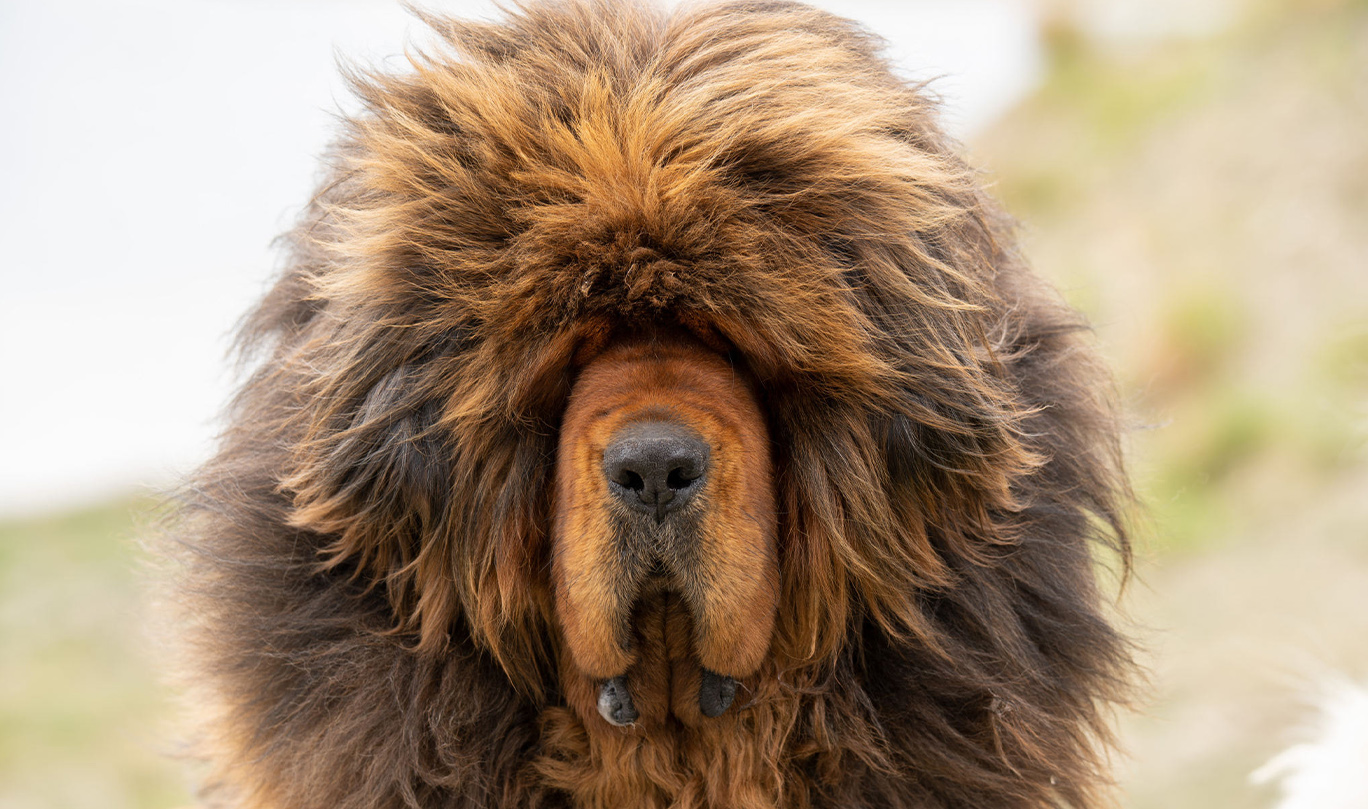The Tibetan Mastiff, commonly revered as “the Holy Dog,” transcends its status as a mere breed, embodying a living connection to Tibet’s ancient and enigmatic culture. For centuries, these majestic canines have been integral to the fabric of Tibetan life, their historical roots weaving into the very essence of the region. Our exploration of the Tibetan Mastiff beckons us into a journey through time, where we delve into the captivating narrative of these regal dogs. This odyssey will unravel the unique traits that define them, shed light on their profound cultural importance, and illuminate the challenges they face in adapting to the contemporary world.
In the high-altitude realms of Tibet, the Tibetan Mastiff stands not only as a physical presence but as a guardian of traditions and a symbol of enduring heritage. Its history, reaching back centuries, mirrors the resilience of the Tibetan people and their deep connection with these magnificent creatures. Together, we embark on a quest to understand the Tibetan Mastiff beyond its physical prowess—exploring its distinct characteristics, unraveling the cultural significance woven into its very existence, and navigating the intricate challenges it encounters in the ever-evolving modern landscape.

Historical Significance: A Timeless Connection to Tibet's Past
Nestled in the elevated terrains of Tibet, the Tibetan Mastiff has stood as a devoted companion to the region's inhabitants for centuries. Far transcending the conventional role of a mere pet, these majestic dogs have become integral to the very fabric of Tibetan culture. Serving as guardians, herders, and symbols of nobility, the Tibetan Mastiff embodies a profound connection that stretches back through the annals of time. As we embark on an exploration of their historical roots, a narrative unfolds, revealing a bond that surpasses the conventional boundaries of human-canine companionship.
In the rarified air of the Tibetan Plateau, these regal dogs have not only shared the hearths of local families but have also taken on roles that reflect the essence of Tibetan life. Their historical significance extends beyond the individual households they protect; they stand as living testaments to the enduring spirit of a culture intricately interwoven with the presence of these majestic canines.
Distinct Characteristics: Ferocity, Loyalty, and Intelligence Unleashed
The Tibetan Mastiff embodies the extraordinary forces of nature, showcasing a ferocity that rivals even lions and tigers. In their majestic presence, these giants exude a captivating blend of aristocratic aloofness and undeniable elegance. Beyond their imposing stature, the Tibetan Mastiffs redefine loyalty, transcending the conventional role of pets. They seamlessly integrate into the family dynamic, considering themselves integral family members rather than mere companions. Behind their intense gaze lies a remarkable intelligence that distinguishes them from other breeds, contributing to their multifaceted and awe-inspiring nature.
In the world of canine companions, the Tibetan Mastiff stands out not just for its physical prowess but for its deep-rooted loyalty, unmatched elegance, and a level of intelligence that goes beyond the ordinary. These distinct characteristics make the Tibetan Mastiff a unique and formidable presence, leaving an indelible mark on those fortunate enough to witness their majestic presence.
Naming Conventions: From Ao to Dokhyi
Unraveling the linguistic tapestry of Tibetan Mastiff naming conventions provides insights into the breed's historical significance. In ancient Tibetan dictionaries, the majestic canine was identified as "Ao," denoting a dog exceeding four chi in length. This term not only emphasized their considerable size but also hinted at the breed's wild, fierce, and unruly characteristics. Conversely, within the Tibetan culture, the nomenclature takes a different turn, labeling them as "Dokhyi," a term translating to a tethered dog. This name sheds light on a traditional practice deeply rooted in the Tibetan way of life, where these formidable guardians are often chained to wooden stakes. This unique nomenclature unveils the breed's territorial nature and highlights their innate protective instincts, symbolizing a harmonious blend of linguistic heritage and cultural practices.
The duality in naming reflects the multifaceted role the Tibetan Mastiff plays, being not only a symbol of strength and nobility but also a practical guardian, intricately woven into the fabric of Tibetan traditions.
Geographical Distribution: From the Plateau to the World
The Tibetan Mastiff, known for its resilience to harsh conditions, thrives in the frigid zones of the Qinghai-Tibet Plateau. Its natural habitat in regions such as Tibet, Inner Mongolia, and Xinjiang reflects its historical connection with the pastoral communities of these areas. Beyond its traditional homelands, the influence of the Tibetan Mastiff has transcended geographical boundaries, reaching far beyond the Plateau. In the global landscape, these majestic dogs have become the ancestors to many modern giant dog breeds, leaving an indelible mark on canine heritage around the world.
In the vast expanses of the Qinghai-Tibet Plateau, the Tibetan Mastiff has not only endured the challenging climate but has also contributed to the evolution of giant dog breeds. Its journey from the high-altitude regions to international recognition underscores the breed's adaptability and the enduring appeal of its distinctive characteristics.
Domestication by Tibetan People: More Than Just a Companion
In the vast expanse of northwestern China, where resilient ethnic minorities have thrived for centuries, the Tibetan Mastiff transcends its role as a mere companion. For these hardy communities, this majestic breed transforms into a reliable assistant intricately woven into the fabric of daily life and production. Specifically bred for the demanding tasks of hunting and herding, the Tibetan Mastiff emerges as an indispensable member of these families, characterized by unwavering loyalty and a fierce protective instinct towards both human and animal members of the kin.
These dogs, with their imposing stature and innate intelligence, stand as pillars of support for the ethnic minorities in their everyday activities. Whether safeguarding the homestead or assisting in herding, the Tibetan Mastiff's role extends far beyond a traditional pet, symbolizing a dynamic partnership between humans and animals in the challenging landscapes of northwestern China.
Cultural Symbolism: Guardians of Heritage
In the tapestry of Tibetan traditions and folklore, the Tibetan Mastiff transcends the role of a mere canine companion; it emerges as a profound symbol embodying nobility, strength, and unwavering loyalty. Within the rich cultural landscape of Tibet, these majestic dogs are revered not only for their physical prowess but also for their symbolic significance. They serve as guardians of heritage, standing as stalwart protectors not just of the family unit but extending their watchful presence to encompass the family's prized cattle and horses. This deep connection instills a profound sense of cultural pride, weaving the Tibetan Mastiff into the very fabric of Tibetan heritage.
In the hearts and minds of the Tibetan people, the presence of the Tibetan Mastiff represents more than a guardian; it reflects a living embodiment of values passed down through generations. The cultural symbolism attached to these regal dogs reinforces their integral role in preserving the essence of Tibetan identity, making them not just revered pets but revered custodians of a rich and enduring heritage.
Challenges in Conservation: Preserving a Living Fossil
The Tibetan Mastiff, with its profound historical significance, confronts a pressing issue—the alarming decline in its purebred population. This revered breed has found itself listed in Category II under state protection, signaling the need for urgent conservation efforts. The delicate task at hand involves striking a balance between preserving the breed's heritage and adapting to the evolving dynamics of the modern world. This challenge requires thoughtful strategies to ensure the continued existence of the Tibetan Mastiff as a living testament to ancient traditions.
In navigating the complexities of conservation, there arises a poignant responsibility to safeguard the genetic integrity of the Tibetan Mastiff while acknowledging the shifts in societal and environmental landscapes. The urgency lies not only in preserving a breed but in maintaining a link to the past, where these majestic dogs were more than pets—they were guardians of cultural heritage.
Tibetan Mastiff in Modern Context: Adaptation and Companionship
In the contemporary landscape where ancient traditions seamlessly integrate with modern lifestyles, the Tibetan Mastiff has evolved beyond its historical role as a working dog. This majestic breed has skillfully adapted to the changing dynamics of the world, embracing a new and diverse set of responsibilities. No longer confined to traditional duties, Tibetan Mastiffs have transitioned into cherished companions within households worldwide.
In the present day, these remarkable dogs offer more than their formidable stature and protective instincts. They have seamlessly woven themselves into the fabric of family life, providing unwavering loyalty and a distinctive combination of ferocity and elegance. Whether guarding a rural homestead or lounging in urban living rooms, the Tibetan Mastiff's ability to adapt speaks to its timeless appeal, making it a beloved and integral part of modern homes across the globe.
Tethering Tradition: Unveiling Cultural Practices
The practice of tethering Tibetan Mastiffs, embodied in the name "Dokhyi," unveils a deeply ingrained cultural tradition within the pastoral lifestyle of the Tibetan people. In the vast expanses of Tibet, where these majestic dogs roam, the act of tethering goes beyond a mere restraint; it symbolizes a connection to the land, a commitment to safeguarding territory, and a testament to ancestral bonds. As strangers draw near, the resonant barks and wild leaps of the Tibetan Mastiffs echo the age-old narrative of territorial protection, echoing through the chain's rattling links like a living chronicle etched in the vast landscapes of the Tibetan Plateau.
In the high-altitude regions where these regal canines thrive, the tradition of tethering is a cultural thread that weaves together the intricate tapestry of Tibetan heritage. It encapsulates not just a practical approach to canine management but serves as a tangible expression of the symbiotic relationship between the Tibetan people and their loyal companions.
Comparison with Other Dog Breeds: Standing Alone in Majesty
In the expansive realm of canine diversity, the Tibetan Mastiff emerges as a solitary figure, unparalleled and distinct from its counterparts. Its regal presence, marked by a combination of majestic appearance, unique behavior, and an unwavering sense of loyalty, elevates it beyond the status of an ordinary dog. Standing alone in majesty, the Tibetan Mastiff's aura is one of nobility and grace, encapsulating a lineage that traces back to ancient times.
The Tibetan Mastiff's distinction lies not only in its physical attributes but also in its temperament and deep-rooted loyalty. Unlike other breeds, these dogs embody the essence of regal guardianship, exhibiting a steadfast commitment to their human companions that extends beyond the ordinary. Their ability to stand alone in majesty is a testament to the breed's enduring legacy and its capacity to evoke a sense of awe and admiration in the vast and diverse landscape of canine companionship.
Tibetan Mastiff in Western Culture: A Global Phenomenon
The Tibetan Mastiff, once confined to the borders of Tibet, has transcended geographical boundaries to achieve widespread acclaim in Western cultures. Beyond the rugged landscapes of its origin, this majestic breed has garnered recognition and admiration in Western countries. Its imposing stature and captivating presence have turned it into a sought-after canine companion, captivating the hearts of dog enthusiasts around the world. In the global tapestry of dog breeds, the Tibetan Mastiff has firmly established itself as a phenomenon, weaving its way into the hearts and households of those who appreciate its regal demeanor and unique attributes.
Whether gracing the pages of magazines or making appearances in movies, the Tibetan Mastiff's influence extends far beyond its traditional habitat. Its global recognition not only reflects its physical magnificence but also underscores the universal appeal of its distinctive character. As a result, the Tibetan Mastiff stands as a symbol of cross-cultural admiration, transcending borders to become a cherished member of the canine community on a global scale.
Tibetan Mastiff Myths and Legends: Separating Fact from Fiction
Myth and legend intertwine with the history of the Tibetan Mastiff, an ancient and revered creature. Countless narratives weave a tapestry of supernatural powers and legendary battles around this majestic breed. Delving into these tales, we embark on a journey to separate fact from fiction, pulling at the threads of truth that intricately weave through the fabric of myth.
In exploring the realm of Tibetan Mastiff myths and legends, one encounters enchanting stories that elevate these dogs beyond the ordinary. Whether it's tales of mystical abilities or heroic feats, the narratives surrounding these regal canines add layers to their mystique. As we unravel the rich tapestry of lore, we aim to discern the reality behind the captivating myths that have contributed to the enduring allure of the Tibetan Mastiff.
Training and Socialization: Nurturing Loyalty and Intelligence
Training and socializing the Tibetan Mastiff is a multifaceted process that transcends mere physical conditioning. It entails delving into the breed's innate loyalty and intelligence, unlocking the full potential of these majestic dogs. The journey involves more than just obedience; it's about fostering a deep bond between the Tibetan Mastiff and its human companions. This breed exhibits the remarkable ability to make independent decisions, showcasing not only its intelligence but also its capacity for understanding and responding to its surroundings. The training process becomes a mutual exchange, where the Tibetan Mastiff thrives on the guidance and trust shared within the unique partnership with its owners.
In the realm of the Tibetan Mastiff, socialization is a key aspect that shapes their behavior and interactions. It goes beyond exposing them to different environments; it's about instilling a sense of confidence and adaptability. Proper socialization ensures that Tibetan Mastiffs can navigate various situations with grace and poise, making them not only formidable protectors but also amiable companions. As these dogs mature into their roles, the combination of thoughtful training and positive social experiences establishes the Tibetan Mastiff as a breed that seamlessly integrates into the fabric of its human family, contributing to a harmonious and enriching coexistence.
Conclusion of Tibetan Mastiff
In conclusion, our exploration into the captivating realm of the Tibetan Mastiff reveals a breed that transcends the traditional role of a pet, emerging as living symbols of a profound cultural legacy. Beyond being mere companions, these dogs embody centuries of history, marked by their historical significance and unwavering loyalty. In the face of contemporary challenges, the Tibetan Mastiff stands resilient, representing a majestic beauty that transcends time.
The Tibetan Mastiff's legacy extends beyond its physical prowess to become a poignant reflection of the resilience inherent in both the breed and the cultural tapestry it is woven into. As custodians of a heritage that spans generations, these dogs encapsulate the essence of a majestic past, offering a timeless connection between the ancient traditions of Tibet and the challenges posed by the modern world.
FAQS about Tibetan Mastiff
Are Tibetan Mastiffs good family pets?
Tibetan Mastiffs are frequently tethered as a customary practice deeply embedded in their cultural heritage. The term "Dokhyi" in their Tibetan name signifies this age-old tradition, which serves dual purposes of territorial protection and vigilant guarding. This practice is rooted in the historical role of Tibetan Mastiffs as guardians of family and property, where their presence is not only a symbol of loyalty but also a practical measure to deter potential intruders, emphasizing their innate instinct to protect their designated territory.
The act of tethering is a testament to the breed's historical connection with the Tibetan people, reflecting a harmonious coexistence that blends the functional aspects of safeguarding with the cultural significance of these majestic dogs. It highlights the importance of understanding and respecting the traditional practices that have shaped the Tibetan Mastiff into the revered and formidable guardians they are known to be.
Why are Tibetan Mastiffs often tethered?
Tibetan Mastiffs have the potential to make wonderful additions to families when given the right care and attention. To thrive as family pets, it's crucial that they undergo proper training and socialization from an early stage. With early intervention, these majestic dogs can showcase their loyalty, intelligence, and protective instincts in a way that harmoniously integrates them into the family dynamic. Adequate guidance ensures that their innate qualities enhance the family experience rather than pose challenges, making Tibetan Mastiffs a rewarding choice for those willing to invest time and effort in their upbringing.
How do Tibetan Mastiffs adapt to modern living conditions?
In response to the question regarding how Tibetan Mastiffs adapt to modern living conditions, it's noteworthy that these majestic dogs exhibit remarkable flexibility. Tibetan Mastiffs, known for their historical roles as guardians and herders in the traditional Tibetan way of life, have seamlessly transitioned into contemporary settings. Embracing their adaptability, they have evolved beyond their original roles and embraced a new purpose as devoted and loyal companions within modern households.
The transition from traditional responsibilities to becoming cherished members of families around the world showcases the Tibetan Mastiff's ability to not only endure but thrive in changing environments. Their inherent loyalty and distinctive characteristics, once harnessed for protective and working purposes, now contribute to fostering deep connections with their human counterparts in a more domestic setting.
What are the main challenges in conserving purebred Tibetan Mastiffs?
Conserving purebred Tibetan Mastiffs presents a multifaceted challenge rooted in two significant factors. Firstly, the breed faces a pressing issue of declining numbers, raising concerns about the preservation of its unique genetic heritage. This decline may result from various factors, including reduced breeding rates, limited gene pools, and increased demand for the breed. Secondly, the changing landscape of lifestyle and habitat further complicates conservation efforts. As traditional ways of life evolve and human settlements encroach upon natural territories, the Tibetan Mastiff's ability to thrive in its native environment diminishes. These dual challenges underscore the urgent need for comprehensive conservation strategies to ensure the continued existence of this revered and historically significant canine lineage.
Addressing the declining numbers and adapting to the shifting dynamics of lifestyle and habitat requires collaborative efforts from breed enthusiasts, conservation organizations, and local communities. By implementing sustainable breeding practices, raising awareness about the breed's unique characteristics, and fostering responsible ownership, we can collectively work towards securing the future of purebred Tibetan Mastiffs in a changing world.
Can Tibetan Mastiffs coexist with other pets?
Tibetan Mastiffs, known for their loyalty and protective instincts, can peacefully coexist with other pets when provided with adequate training and socialization. Through proper guidance from their owners, these majestic dogs can form harmonious relationships within a household, fostering a sense of companionship with other animals.
Ensuring a positive environment for cohabitation involves introducing Tibetan Mastiffs to other pets gradually, allowing them to acclimate and build mutual understanding. With patience, consistency, and positive reinforcement, these intelligent and adaptable dogs can demonstrate remarkable compatibility, creating a cohesive and loving atmosphere where various pets can thrive together.
About Tibet Travel & Tours
Tibet Travel & Tours is a local travel agency in Tibet that offers unique and authentic experiences to travelers from all around the world. As a leading tour operator in Tibet, we provide high-quality Tibet Travel services that are tailored to our clients' needs and preferences.
Our team of experienced and knowledgeable professionals strives to ensure that our clients have a hassle-free and memorable trip in Tibet. We specialize in various types of tours, including cultural tours, trekking and hiking tours, and adventure tours.
Our commitment to providing exceptional service has earned us a reputation as one of the best local travel agencies in Tibet. Contact us today to plan your unforgettable trip to Tibet.
Explore Tibet with a local Tibetan Travel Agency
If you're looking to explore Tibet, starting your journey with a reputable Tibetan travel agency in Tibet is crucial. Tibet Travel & Tours is a great choice to begin your adventure with their extensive knowledge of the region and commitment to responsible tourism.
Their Tibet tour packages cater to a range of interests and budgets, making it easy to plan a trip that suits your needs. Before embarking on your tibet tour, it's essential to have the right Tibet travel information and necessary documents, including a Tibet travel permit.
The Tibet Travel Planner provided by i-Tibet travel is an excellent resource to plan your trip, including tips on what to pack, where to stay, and what to see.
For beginners, the "About Tibet" guide provided by i-Tibet travel offers a comprehensive overview of the region's history, culture, and top attractions. So, start your Tibet travel plan here with i-Tibet travel and discover the magic of Tibet for yourself.










